A Research Essay on the Socio-Economic Impact of HIV/AIDS in Bhutan
VerifiedAdded on 2023/04/21
|8
|2033
|344
Essay
AI Summary
This essay explores the impact of HIV/AIDS on the quality of life of people in Bhutan, focusing on social challenges and the overall disease burden. It highlights that despite Bhutan's geographical isolation, HIV/AIDS remains a significant public health concern, primarily transmitted through unprotected sexual intercourse. The research identifies vulnerable groups, including sex workers, and discusses the social stigma and lack of awareness that diminish the quality of life for affected individuals. The essay suggests engaging community-based organizations, strengthening policy-making, and implementing community support programs to improve access to treatment and alleviate the standard of living for patients. It concludes that addressing these issues through targeted interventions is crucial for advocating the rights of affected patients and preventing further transmission in Bhutan.
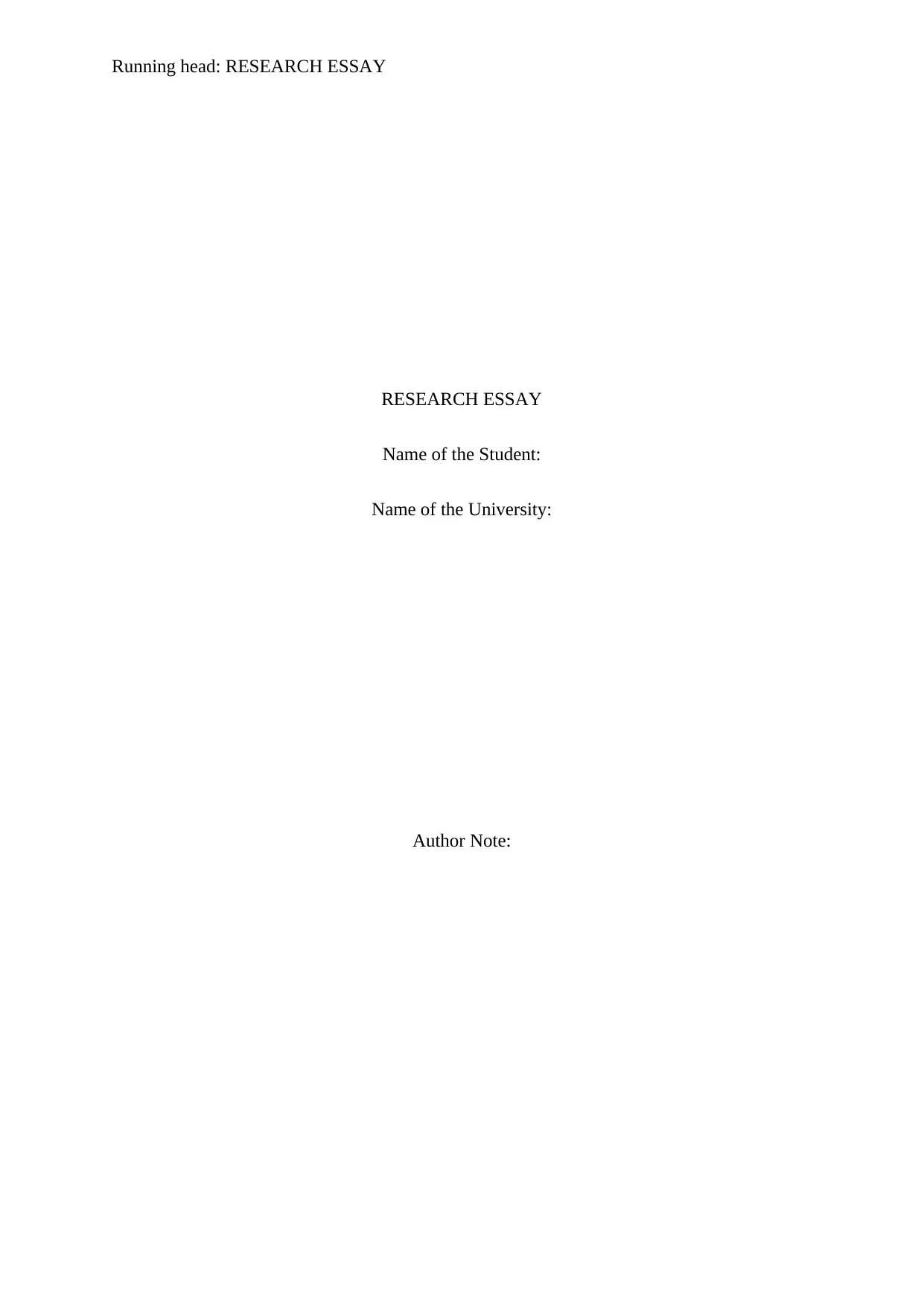
Running head: RESEARCH ESSAY
RESEARCH ESSAY
Name of the Student:
Name of the University:
Author Note:
RESEARCH ESSAY
Name of the Student:
Name of the University:
Author Note:
Paraphrase This Document
Need a fresh take? Get an instant paraphrase of this document with our AI Paraphraser
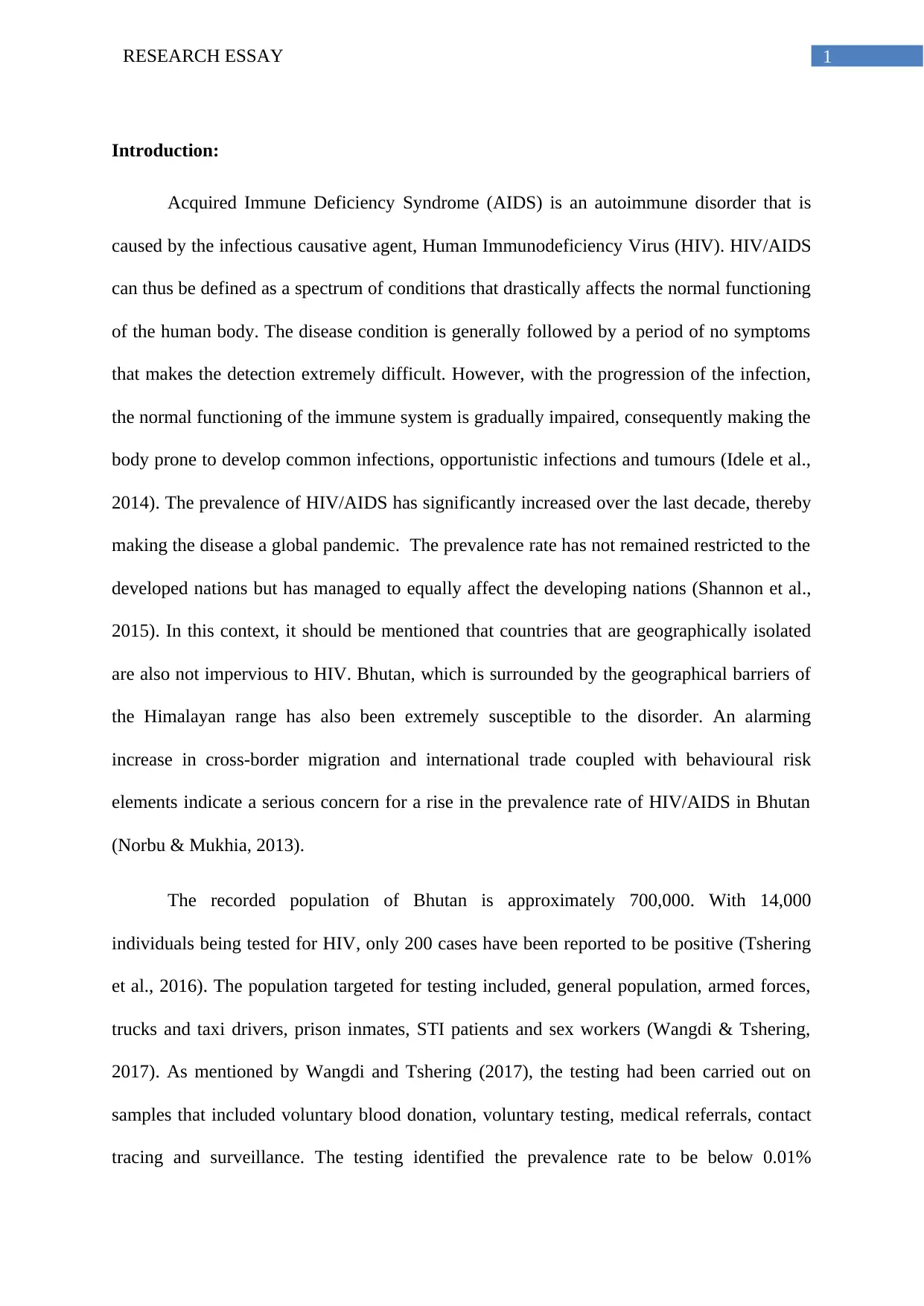
1RESEARCH ESSAY
Introduction:
Acquired Immune Deficiency Syndrome (AIDS) is an autoimmune disorder that is
caused by the infectious causative agent, Human Immunodeficiency Virus (HIV). HIV/AIDS
can thus be defined as a spectrum of conditions that drastically affects the normal functioning
of the human body. The disease condition is generally followed by a period of no symptoms
that makes the detection extremely difficult. However, with the progression of the infection,
the normal functioning of the immune system is gradually impaired, consequently making the
body prone to develop common infections, opportunistic infections and tumours (Idele et al.,
2014). The prevalence of HIV/AIDS has significantly increased over the last decade, thereby
making the disease a global pandemic. The prevalence rate has not remained restricted to the
developed nations but has managed to equally affect the developing nations (Shannon et al.,
2015). In this context, it should be mentioned that countries that are geographically isolated
are also not impervious to HIV. Bhutan, which is surrounded by the geographical barriers of
the Himalayan range has also been extremely susceptible to the disorder. An alarming
increase in cross-border migration and international trade coupled with behavioural risk
elements indicate a serious concern for a rise in the prevalence rate of HIV/AIDS in Bhutan
(Norbu & Mukhia, 2013).
The recorded population of Bhutan is approximately 700,000. With 14,000
individuals being tested for HIV, only 200 cases have been reported to be positive (Tshering
et al., 2016). The population targeted for testing included, general population, armed forces,
trucks and taxi drivers, prison inmates, STI patients and sex workers (Wangdi & Tshering,
2017). As mentioned by Wangdi and Tshering (2017), the testing had been carried out on
samples that included voluntary blood donation, voluntary testing, medical referrals, contact
tracing and surveillance. The testing identified the prevalence rate to be below 0.01%
Introduction:
Acquired Immune Deficiency Syndrome (AIDS) is an autoimmune disorder that is
caused by the infectious causative agent, Human Immunodeficiency Virus (HIV). HIV/AIDS
can thus be defined as a spectrum of conditions that drastically affects the normal functioning
of the human body. The disease condition is generally followed by a period of no symptoms
that makes the detection extremely difficult. However, with the progression of the infection,
the normal functioning of the immune system is gradually impaired, consequently making the
body prone to develop common infections, opportunistic infections and tumours (Idele et al.,
2014). The prevalence of HIV/AIDS has significantly increased over the last decade, thereby
making the disease a global pandemic. The prevalence rate has not remained restricted to the
developed nations but has managed to equally affect the developing nations (Shannon et al.,
2015). In this context, it should be mentioned that countries that are geographically isolated
are also not impervious to HIV. Bhutan, which is surrounded by the geographical barriers of
the Himalayan range has also been extremely susceptible to the disorder. An alarming
increase in cross-border migration and international trade coupled with behavioural risk
elements indicate a serious concern for a rise in the prevalence rate of HIV/AIDS in Bhutan
(Norbu & Mukhia, 2013).
The recorded population of Bhutan is approximately 700,000. With 14,000
individuals being tested for HIV, only 200 cases have been reported to be positive (Tshering
et al., 2016). The population targeted for testing included, general population, armed forces,
trucks and taxi drivers, prison inmates, STI patients and sex workers (Wangdi & Tshering,
2017). As mentioned by Wangdi and Tshering (2017), the testing had been carried out on
samples that included voluntary blood donation, voluntary testing, medical referrals, contact
tracing and surveillance. The testing identified the prevalence rate to be below 0.01%

2RESEARCH ESSAY
(Tshering et al., 2016). According to UNAIDS, it has been predicted that on an average, less
than 1000 people could be living with AIDS without being aware of the fact (Norbu &
Mukhia, 2013). Hence, efforts are being made to identify existing cases so as to devise better
prevention strategies and at the same time improve the quality of life of the affected
individuals.
Research Question:
On the basis of the background information about the prevalence of HIV/AIDS in
Bhutan, the formulated research questions are:
RQ1: How does HIV/AIDS affect the quality of the life of people in Bhutan?
RQ2: What are the social challenges encountered by the affected patients?
Research Objectives:
The research objectives with reference to the formulated research questions can be
enlisted as follows:
To investigate and analyse the quality of life of affected patients
To estimate the social challenges encountered by the affected patients
Research Rationale:
The rationale for conducting the research can be enlisted as the research gap in terms
of estimating the disease burden in a geographically distant country such as Bhutan. It should
be critically noted in this context, that on account of the low population base, the country has
(Tshering et al., 2016). According to UNAIDS, it has been predicted that on an average, less
than 1000 people could be living with AIDS without being aware of the fact (Norbu &
Mukhia, 2013). Hence, efforts are being made to identify existing cases so as to devise better
prevention strategies and at the same time improve the quality of life of the affected
individuals.
Research Question:
On the basis of the background information about the prevalence of HIV/AIDS in
Bhutan, the formulated research questions are:
RQ1: How does HIV/AIDS affect the quality of the life of people in Bhutan?
RQ2: What are the social challenges encountered by the affected patients?
Research Objectives:
The research objectives with reference to the formulated research questions can be
enlisted as follows:
To investigate and analyse the quality of life of affected patients
To estimate the social challenges encountered by the affected patients
Research Rationale:
The rationale for conducting the research can be enlisted as the research gap in terms
of estimating the disease burden in a geographically distant country such as Bhutan. It should
be critically noted in this context, that on account of the low population base, the country has
⊘ This is a preview!⊘
Do you want full access?
Subscribe today to unlock all pages.

Trusted by 1+ million students worldwide

3RESEARCH ESSAY
not been given much importance in context of evaluating the plight of HIV/AIDS on affected
patients. With the little research available on the epidemiological prevalence of HIV/AIDS in
the nation, this research study intends to evaluate the factors that affect the quality of the life
of the affected individuals. In addition to this, it also intends to explore the social barriers that
affected individuals encounter. It should be mentioned here that the research would be useful
in identifying the challenges faced by the infected individuals and accordingly devise sound
strategies to address the identified problems. It would also help in acquiring the responses of
the infected patients and bring to the forefront the importance of creating relief policies so as
to alleviate the standard of living of the infected patients.
Literature Review:
The population base of Bhutan comprises of people who belong to diverse
professional background that include, armed forces, farmers, civilians and sex workers
(Norbu & Mukhia, 2013). As indicated by a research study, it was found that the primary
mode of infection transmission was sexual. The target age group of the affected individuals
range from 20 to 49 years of age (Chang et al., 2013). However, reports have indicated that
the prevalence of infection between men and women are almost equal. Studies mention that,
the AIDS prevention program has not been able to reach certain population subgroups that
are vulnerable to the disease. As mentioned by Emmanuel et al. (2013), the most popular
mode of transmission of the infection can be enlisted as injecting drug use, MSM (Men who
have sex with Men) relationships and sex work. However, in case of Bhutan, the primary
mode of transmission has been identified to be unprotected sexual intercourse. Informal sex
work and casual sexual networking practice in Bhutan is not appropriately addressed by the
wellness campaigns as it is not detected due to societal stigma and negative perception of the
society. As mentioned by Wangdi and Tshering (2017), sex workers are perceived as
not been given much importance in context of evaluating the plight of HIV/AIDS on affected
patients. With the little research available on the epidemiological prevalence of HIV/AIDS in
the nation, this research study intends to evaluate the factors that affect the quality of the life
of the affected individuals. In addition to this, it also intends to explore the social barriers that
affected individuals encounter. It should be mentioned here that the research would be useful
in identifying the challenges faced by the infected individuals and accordingly devise sound
strategies to address the identified problems. It would also help in acquiring the responses of
the infected patients and bring to the forefront the importance of creating relief policies so as
to alleviate the standard of living of the infected patients.
Literature Review:
The population base of Bhutan comprises of people who belong to diverse
professional background that include, armed forces, farmers, civilians and sex workers
(Norbu & Mukhia, 2013). As indicated by a research study, it was found that the primary
mode of infection transmission was sexual. The target age group of the affected individuals
range from 20 to 49 years of age (Chang et al., 2013). However, reports have indicated that
the prevalence of infection between men and women are almost equal. Studies mention that,
the AIDS prevention program has not been able to reach certain population subgroups that
are vulnerable to the disease. As mentioned by Emmanuel et al. (2013), the most popular
mode of transmission of the infection can be enlisted as injecting drug use, MSM (Men who
have sex with Men) relationships and sex work. However, in case of Bhutan, the primary
mode of transmission has been identified to be unprotected sexual intercourse. Informal sex
work and casual sexual networking practice in Bhutan is not appropriately addressed by the
wellness campaigns as it is not detected due to societal stigma and negative perception of the
society. As mentioned by Wangdi and Tshering (2017), sex workers are perceived as
Paraphrase This Document
Need a fresh take? Get an instant paraphrase of this document with our AI Paraphraser
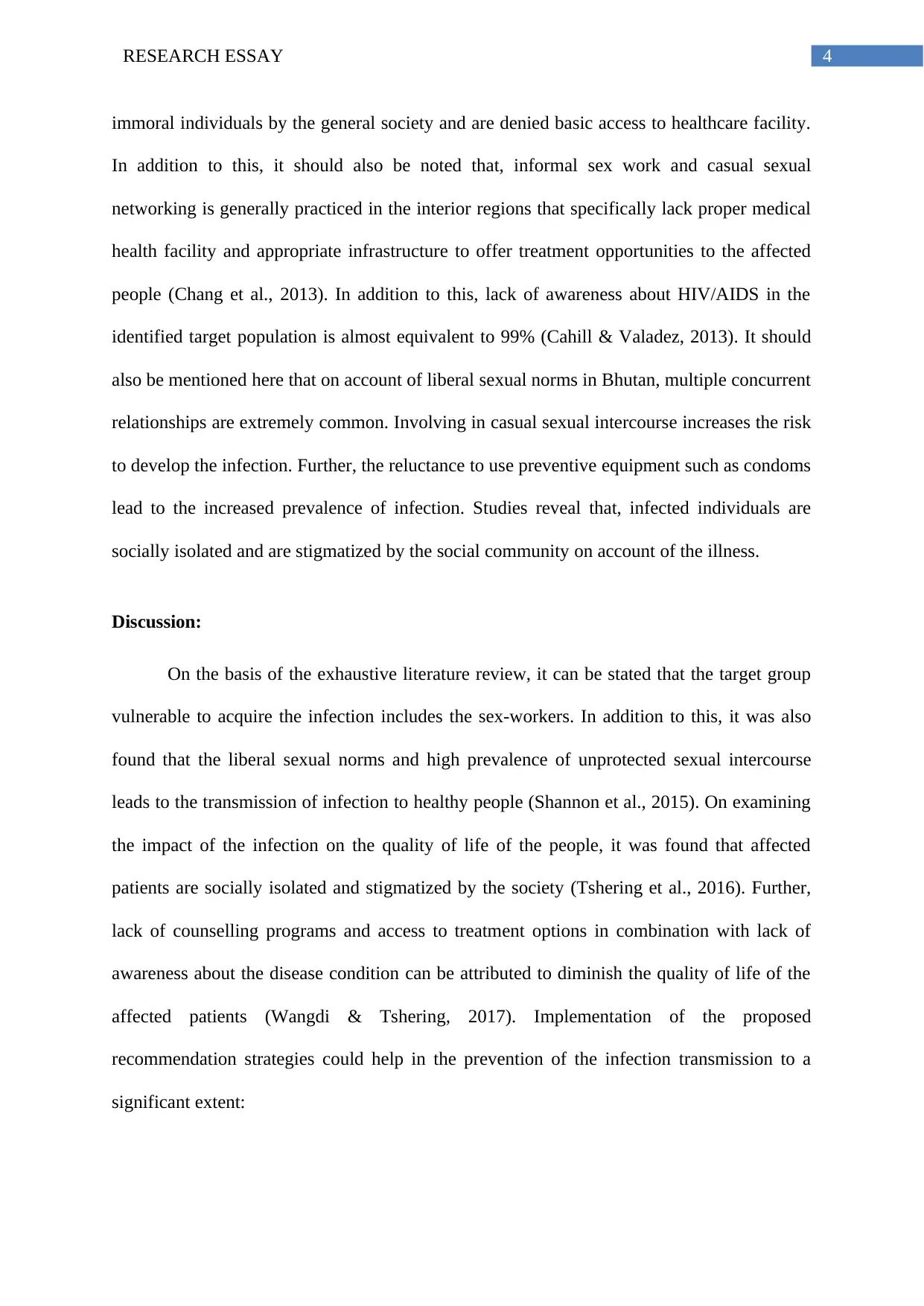
4RESEARCH ESSAY
immoral individuals by the general society and are denied basic access to healthcare facility.
In addition to this, it should also be noted that, informal sex work and casual sexual
networking is generally practiced in the interior regions that specifically lack proper medical
health facility and appropriate infrastructure to offer treatment opportunities to the affected
people (Chang et al., 2013). In addition to this, lack of awareness about HIV/AIDS in the
identified target population is almost equivalent to 99% (Cahill & Valadez, 2013). It should
also be mentioned here that on account of liberal sexual norms in Bhutan, multiple concurrent
relationships are extremely common. Involving in casual sexual intercourse increases the risk
to develop the infection. Further, the reluctance to use preventive equipment such as condoms
lead to the increased prevalence of infection. Studies reveal that, infected individuals are
socially isolated and are stigmatized by the social community on account of the illness.
Discussion:
On the basis of the exhaustive literature review, it can be stated that the target group
vulnerable to acquire the infection includes the sex-workers. In addition to this, it was also
found that the liberal sexual norms and high prevalence of unprotected sexual intercourse
leads to the transmission of infection to healthy people (Shannon et al., 2015). On examining
the impact of the infection on the quality of life of the people, it was found that affected
patients are socially isolated and stigmatized by the society (Tshering et al., 2016). Further,
lack of counselling programs and access to treatment options in combination with lack of
awareness about the disease condition can be attributed to diminish the quality of life of the
affected patients (Wangdi & Tshering, 2017). Implementation of the proposed
recommendation strategies could help in the prevention of the infection transmission to a
significant extent:
immoral individuals by the general society and are denied basic access to healthcare facility.
In addition to this, it should also be noted that, informal sex work and casual sexual
networking is generally practiced in the interior regions that specifically lack proper medical
health facility and appropriate infrastructure to offer treatment opportunities to the affected
people (Chang et al., 2013). In addition to this, lack of awareness about HIV/AIDS in the
identified target population is almost equivalent to 99% (Cahill & Valadez, 2013). It should
also be mentioned here that on account of liberal sexual norms in Bhutan, multiple concurrent
relationships are extremely common. Involving in casual sexual intercourse increases the risk
to develop the infection. Further, the reluctance to use preventive equipment such as condoms
lead to the increased prevalence of infection. Studies reveal that, infected individuals are
socially isolated and are stigmatized by the social community on account of the illness.
Discussion:
On the basis of the exhaustive literature review, it can be stated that the target group
vulnerable to acquire the infection includes the sex-workers. In addition to this, it was also
found that the liberal sexual norms and high prevalence of unprotected sexual intercourse
leads to the transmission of infection to healthy people (Shannon et al., 2015). On examining
the impact of the infection on the quality of life of the people, it was found that affected
patients are socially isolated and stigmatized by the society (Tshering et al., 2016). Further,
lack of counselling programs and access to treatment options in combination with lack of
awareness about the disease condition can be attributed to diminish the quality of life of the
affected patients (Wangdi & Tshering, 2017). Implementation of the proposed
recommendation strategies could help in the prevention of the infection transmission to a
significant extent:
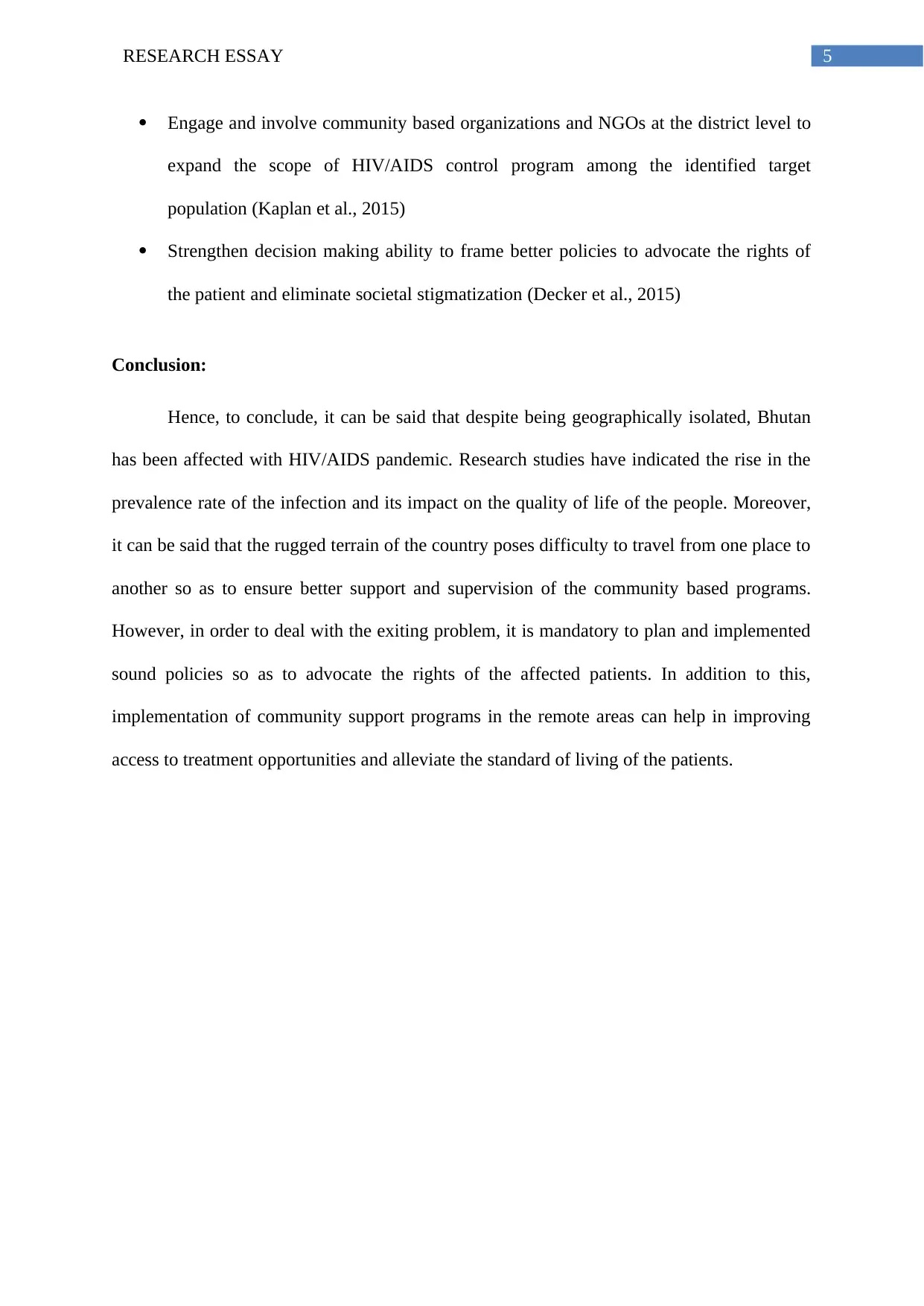
5RESEARCH ESSAY
Engage and involve community based organizations and NGOs at the district level to
expand the scope of HIV/AIDS control program among the identified target
population (Kaplan et al., 2015)
Strengthen decision making ability to frame better policies to advocate the rights of
the patient and eliminate societal stigmatization (Decker et al., 2015)
Conclusion:
Hence, to conclude, it can be said that despite being geographically isolated, Bhutan
has been affected with HIV/AIDS pandemic. Research studies have indicated the rise in the
prevalence rate of the infection and its impact on the quality of life of the people. Moreover,
it can be said that the rugged terrain of the country poses difficulty to travel from one place to
another so as to ensure better support and supervision of the community based programs.
However, in order to deal with the exiting problem, it is mandatory to plan and implemented
sound policies so as to advocate the rights of the affected patients. In addition to this,
implementation of community support programs in the remote areas can help in improving
access to treatment opportunities and alleviate the standard of living of the patients.
Engage and involve community based organizations and NGOs at the district level to
expand the scope of HIV/AIDS control program among the identified target
population (Kaplan et al., 2015)
Strengthen decision making ability to frame better policies to advocate the rights of
the patient and eliminate societal stigmatization (Decker et al., 2015)
Conclusion:
Hence, to conclude, it can be said that despite being geographically isolated, Bhutan
has been affected with HIV/AIDS pandemic. Research studies have indicated the rise in the
prevalence rate of the infection and its impact on the quality of life of the people. Moreover,
it can be said that the rugged terrain of the country poses difficulty to travel from one place to
another so as to ensure better support and supervision of the community based programs.
However, in order to deal with the exiting problem, it is mandatory to plan and implemented
sound policies so as to advocate the rights of the affected patients. In addition to this,
implementation of community support programs in the remote areas can help in improving
access to treatment opportunities and alleviate the standard of living of the patients.
⊘ This is a preview!⊘
Do you want full access?
Subscribe today to unlock all pages.

Trusted by 1+ million students worldwide
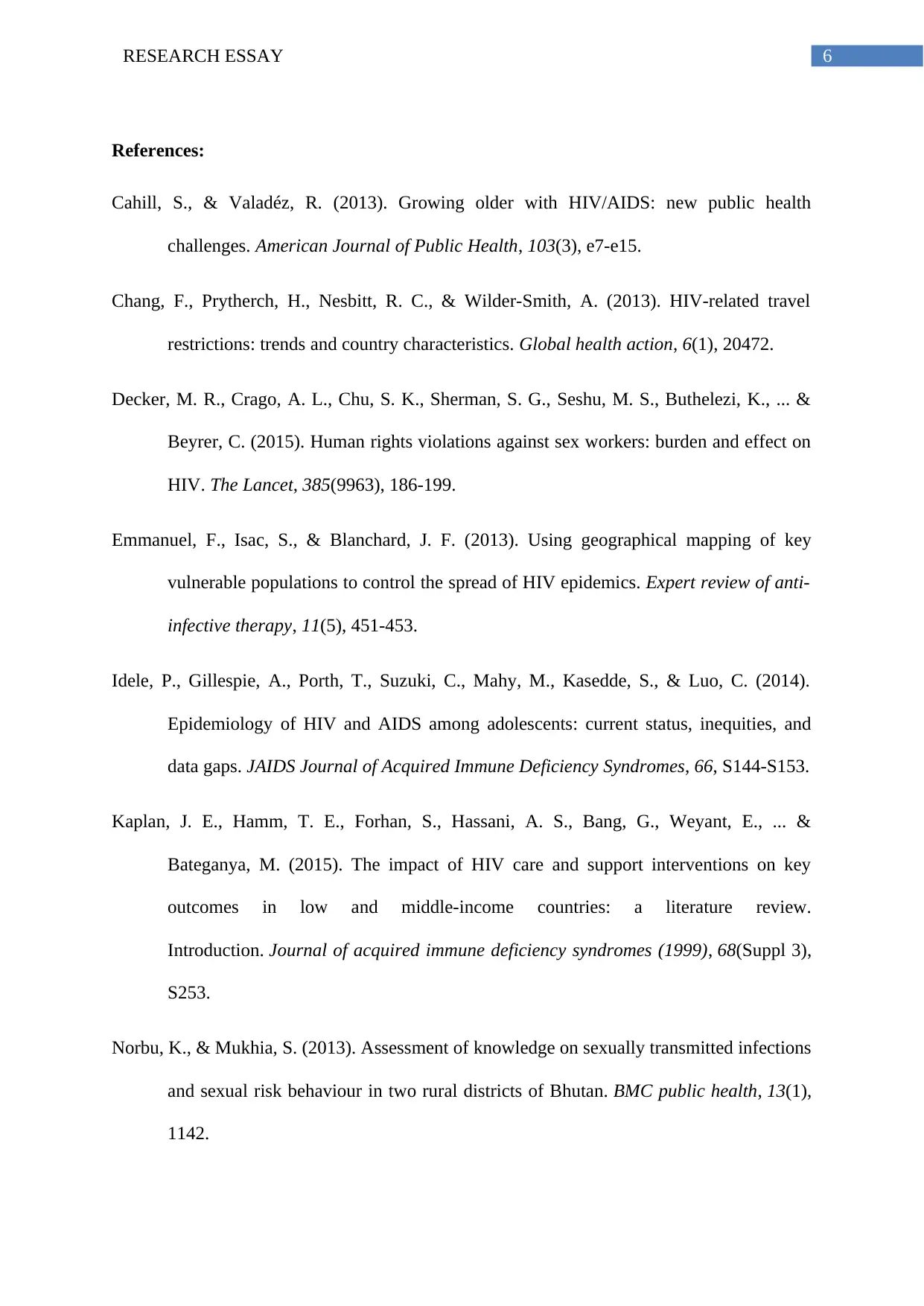
6RESEARCH ESSAY
References:
Cahill, S., & Valadéz, R. (2013). Growing older with HIV/AIDS: new public health
challenges. American Journal of Public Health, 103(3), e7-e15.
Chang, F., Prytherch, H., Nesbitt, R. C., & Wilder-Smith, A. (2013). HIV-related travel
restrictions: trends and country characteristics. Global health action, 6(1), 20472.
Decker, M. R., Crago, A. L., Chu, S. K., Sherman, S. G., Seshu, M. S., Buthelezi, K., ... &
Beyrer, C. (2015). Human rights violations against sex workers: burden and effect on
HIV. The Lancet, 385(9963), 186-199.
Emmanuel, F., Isac, S., & Blanchard, J. F. (2013). Using geographical mapping of key
vulnerable populations to control the spread of HIV epidemics. Expert review of anti-
infective therapy, 11(5), 451-453.
Idele, P., Gillespie, A., Porth, T., Suzuki, C., Mahy, M., Kasedde, S., & Luo, C. (2014).
Epidemiology of HIV and AIDS among adolescents: current status, inequities, and
data gaps. JAIDS Journal of Acquired Immune Deficiency Syndromes, 66, S144-S153.
Kaplan, J. E., Hamm, T. E., Forhan, S., Hassani, A. S., Bang, G., Weyant, E., ... &
Bateganya, M. (2015). The impact of HIV care and support interventions on key
outcomes in low and middle-income countries: a literature review.
Introduction. Journal of acquired immune deficiency syndromes (1999), 68(Suppl 3),
S253.
Norbu, K., & Mukhia, S. (2013). Assessment of knowledge on sexually transmitted infections
and sexual risk behaviour in two rural districts of Bhutan. BMC public health, 13(1),
1142.
References:
Cahill, S., & Valadéz, R. (2013). Growing older with HIV/AIDS: new public health
challenges. American Journal of Public Health, 103(3), e7-e15.
Chang, F., Prytherch, H., Nesbitt, R. C., & Wilder-Smith, A. (2013). HIV-related travel
restrictions: trends and country characteristics. Global health action, 6(1), 20472.
Decker, M. R., Crago, A. L., Chu, S. K., Sherman, S. G., Seshu, M. S., Buthelezi, K., ... &
Beyrer, C. (2015). Human rights violations against sex workers: burden and effect on
HIV. The Lancet, 385(9963), 186-199.
Emmanuel, F., Isac, S., & Blanchard, J. F. (2013). Using geographical mapping of key
vulnerable populations to control the spread of HIV epidemics. Expert review of anti-
infective therapy, 11(5), 451-453.
Idele, P., Gillespie, A., Porth, T., Suzuki, C., Mahy, M., Kasedde, S., & Luo, C. (2014).
Epidemiology of HIV and AIDS among adolescents: current status, inequities, and
data gaps. JAIDS Journal of Acquired Immune Deficiency Syndromes, 66, S144-S153.
Kaplan, J. E., Hamm, T. E., Forhan, S., Hassani, A. S., Bang, G., Weyant, E., ... &
Bateganya, M. (2015). The impact of HIV care and support interventions on key
outcomes in low and middle-income countries: a literature review.
Introduction. Journal of acquired immune deficiency syndromes (1999), 68(Suppl 3),
S253.
Norbu, K., & Mukhia, S. (2013). Assessment of knowledge on sexually transmitted infections
and sexual risk behaviour in two rural districts of Bhutan. BMC public health, 13(1),
1142.
Paraphrase This Document
Need a fresh take? Get an instant paraphrase of this document with our AI Paraphraser

7RESEARCH ESSAY
Shannon, K., Strathdee, S. A., Goldenberg, S. M., Duff, P., Mwangi, P., Rusakova, M., ... &
Boily, M. C. (2015). Global epidemiology of HIV among female sex workers:
influence of structural determinants. The Lancet, 385(9962), 55-71.
Tshering, P., Lhazeen, K., Wangdi, S., & Tshering, N. (2016). Twenty-two years of HIV
infection in Bhutan: epidemiological profile. Journal of virus eradication, 2(Suppl 4),
45.
Wangdi, S., & Tshering, U. (2017). Sexual diversity in Bhutan. Bhutan Health Journal, 3(1),
24-27.
Shannon, K., Strathdee, S. A., Goldenberg, S. M., Duff, P., Mwangi, P., Rusakova, M., ... &
Boily, M. C. (2015). Global epidemiology of HIV among female sex workers:
influence of structural determinants. The Lancet, 385(9962), 55-71.
Tshering, P., Lhazeen, K., Wangdi, S., & Tshering, N. (2016). Twenty-two years of HIV
infection in Bhutan: epidemiological profile. Journal of virus eradication, 2(Suppl 4),
45.
Wangdi, S., & Tshering, U. (2017). Sexual diversity in Bhutan. Bhutan Health Journal, 3(1),
24-27.
1 out of 8
Related Documents
Your All-in-One AI-Powered Toolkit for Academic Success.
+13062052269
info@desklib.com
Available 24*7 on WhatsApp / Email
![[object Object]](/_next/static/media/star-bottom.7253800d.svg)
Unlock your academic potential
Copyright © 2020–2025 A2Z Services. All Rights Reserved. Developed and managed by ZUCOL.





